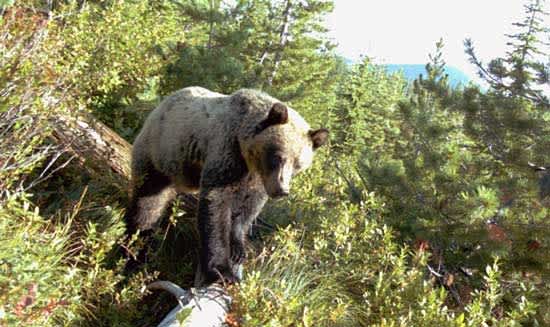Idaho Grizzly Bear Wounded by Hunters Remains Undetected
Idaho Department of Fish and Game 10.04.12

On Saturday, September 22 at approximately 9:30 AM, five hunters from the Upper Valley were in the process of retrieving a bull elk that had been shot with an arrow four days previous when they encountered a charging bear. The individuals were carrying a total of five large caliber pistols and one 12 gauge shotgun loaded with BBB pellets. The incident happened in a split second and resulted in approximately 12 shots being fired, the closest a shotgun blast at a distance of approximately 12 feet from the charging bear. The gunfire turned the bear before it made contact with any of the hunters and a small blood trail indicated that the bear had been hit by at least one of the shots fired.
An hour after the incident occurred an Idaho Fish & Game Conservation Officer and a Fremont County Sheriff’s Deputy returned to the site and confirmed that the bear had been wounded and did not pursue because of the dangers involved with pursuing what was thought to be a wounded grizzly with too small a search party. Immediately after the initial investigation a news release was sent to the media alerting the public to the situation and urging caution. The area was posted by the United States Forest Service (USFS) to alert the public and staff from both IDFG & USFS patrolled the area to alert the public of the situation.
Approximately 24 hours after the initial incident, 5 members of the IDFG Wildlife Human Attack Response Team (WHART) and 2 United States Fish & Wildlife Service Special Agents returned to the site of the incident to collect evidence and determine further action. Before returning to the site a check was made of known radio collared grizzly bears and one bear that had not been there the day before had moved into the immediate area. At the site a grizzly bear was pushed off the bull elk carcass which had been buried even more than the previous day, an indication that grizzlies had claimed the elk for food.
The blood trail of the wounded bear was followed for approximately for a third of a mile before it disappeared. According to Large Carnivore Biologist Bryan Aber, “The amount and location of blood sign indicated that the bear probably was hit in a front leg.” No other sign was detected to indicate that the bear had sustained greater injuries. Samples were collected and sent to a laboratory to determine more about the bear. If the bear was a grizzly that had been handled previously then DNA records could provide a match and reveal more information about the bear.
As of October 3, there has been no new information about the wounded bear or reported sightings of a wounded grizzly. Rumors that a dead grizzly bear had been found in Island Park are false. Because the trail disappeared and there are a number of grizzly bears and black bears in the area the use of dogs to track the wounded bear is not viable. IDFG along with the USFS will continue to monitor the area for any bears which appear to be wounded or acting in a suspicious manner and take the appropriate actions. The public is encouraged to assist in monitoring efforts by immediately reporting to authorities any bears that appear wounded or in areas that could cause an immediate conflict with humans. Throughout the fall hunting season IDFG personnel will continue to make contact with the public to help inform them how they can reduce the potential for conflicts with bears and what to do if bears are encountered.
The public and especially hunters are again reminded that Island Park is bear country and that both black and grizzly bears could be encountered. This recent incident shows that while firearms may turn a charging bear around, they create lingering worries if the bear is not killed, but only wounded. It is recommended that bear spray, which has been shown to be highly effective in deterring charging bears, be carried and used whenever possible. The effects of bear spray are temporary and do not create a situation where the public needs to be concerned about a wounded animal remaining out in the woods.
According To Dr. George Stephens, a retired Neuro Surgeon who specializes in the study of grizzly bear nervous systems and brains, “Grizzly Bears are known to be able to withstand large amounts of physical pain, with the exception of when it is applied to their noses. Their noses are incredibly sensitive and wired directly to their brains.” The annuals of Lewis & Clark document the extreme difficulties that the Corps of Discovery had when they first encountered grizzly bears. According to Captain George Clark, “ …a terrible looking animal, which we found very hard to kill, we Shot ten Balls into him before we killed him, & 5 of those Balls through his lights(brain).”
When venturing into bear country, either hiking or retrieving downed game, the public is reminded that it is important to make plenty of noise and carry bear spray where it accessible. When hunting in bear country it is important to realize that many things that make for being an effective hunter increase your odds of surprising a bear.
To learn more about bears and safety in bear country, visit:
http://fishandgame.idaho.gov/public/education/bearIdentification/
http://www.centerforwildlifeinformation.org/BeBearAware/bebearaware.html

